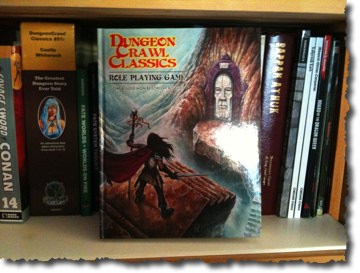Stephan Hornick
Community Goblin & Master of the Archive
Platinum WoA
Wizard of Story
Wizard of Combat
Borderland Explorer

How to Make Undead Scary
By JohnnFour | Published October 27, 2014.
Roleplaying Tips Newsletter #629
Brief Word From Johnn
Freelance Traveller Reviews Faster Combat
Timothy Collinson vivisects my book, The Game Master's Guide to Faster Combats, for the Freelance Traveller zine. It's the most detailed review of my course yet. His main question is, are the lessons and information of value to Traveller and non-D&D GMs?His answer is in this PDF, starting at page 21:
http://www.freelancetraveller.com/magazine/FT058-201410-ANSI-A.pdf
Also, if you are a Traveller GM, you can get all the back issues of the Freelance Traveller zine here (it looks like a fantastic resource):
http://www.freelancetraveller.com/magazine/index.html
New Books On My Shelf
The postman brought me something grim, gritty, and dangerous this week.Dungeon Crawl Classics just hit my mailbox and it looks like a great, old school game.

Character creation is fabulous. The premise is you start with 0 level characters. Farmers, peasants, and commoners who are somehow involved in risky adventure. Perhaps their Baron has recruited them for a dangerous mission, or they've shipwrecked on a mysterious island and must band together to survive, or their village is attacked and they are the sole survivors and homeless.Each player gets a few characters and tries to help as many survive as possible. By the end of the intro adventure, only the strong or lucky are left, and these become first level PCs with a class and your standard PC abilities.
This approach is like gaming your character's backstory. It's low fantasy and gritty, which I'm finding a nice break from the high fantasy stuff I've been consuming in recent years.
Anyway, thanks to Noble Knight Games for the fast shipping and excellent packaging of my used edition. The book came through with nary a scratch.
Get some gaming done this week, if you can swing it.
Cheers,
Johnn

How To Deal With Idea Overwhelm
This issue is full of a ton of ideas. I get overwhelmed when I read articles like this or when I find long forum threads full of awesome.How do I grapple with all these ideas, put them into some kind of order, and integrate them into my campaign?
Here's my iterative process.
Step 1: Setup Your Idea Container
Paste all the content and ideas into MyInfo, Evernote, OneNote, or tool of your choice.Create a container for these ideas so they are separate from your other notes and you can find them quick.
- In MyInfo, create a parent document in the tree and file your ideas underneath as child documents.
- In Evernote, create a Notebook for your campaign and create new notes in it tagged "Idea".
- In OneNote, create a Page in a Section of your campaign's Notebook, and paste ideas into themed sub-pages as you go.
Step 2: Paste Ideas In
Copy the article, posts, or content into your ideas container.Also paste in the URL or make a note about the source in case you want to refer back to it later. For example, "Undead Ideas RPT #629".
Then make all the text italic. I do this so I know the text isn't my writing (for copyright, attribution, etc.). It also helps separate my thoughts, which is important for a later step.
Step 3: Read & Comment
With a good, findable, and reliable spot for all my ideas created, and text pasted in from an article and italicized, next I read through the text and write ideas inline as I go.I keep my ideas in regular text, not italicized. You could make your text bold, red, or whatever you like to identify it as your writing.
As I read, I write any ideas that come to mind below the text that inspired me. So eventually the article is a bunch of alternating text, with the original article interspersed with my thoughts and reactions and ideas.
If there are long passages I don't find useful or inspiring, I delete them. You don't have to do this, especially if you want to preserve all the original text. But I do this to shorten up my docs, as I'm focused more on the ideas I produce from this exercise than on keeping a library of articles.
Comments I make include ideas that pop into mind as I read, thoughts on how I'd integrate the ideas into my campaign, and who or what the idea might get attached to.
For example, if an idea is good for a PC, I'll write the PC's name at the start. "Roscoe: undead pick HIS pockets." In my current campaign, Roscoe is a rogue, so it was an amusing idea to me.
I might also "tag" ideas with NPC names, locations, "history", region names, "treasure", and any other labels that might apply. This just gives me an idea later on where my head was at with the idea. "Ok past Johnn, how were you thinking of applying this to the campaign? Oh, this is a trap idea - got it."
In addition, I can search by keyword or tag now, and find ideas by topic fast. For example, I can just search for "Trap:" or "Roscoe:" and hit search again and again to cycle through all related ideas.
Step 4: Iterate & Crunch
I'll keep doing pass-throughs from top to bottom of the article and flesh out my notes and ideas more as I re-read each time.Ideas that suck I delete or leave alone. The best ideas I highlight or add even more details to.
As I iterate and refine worthy ideas, I make notes about crunch needs. At the end of each note or idea, I'll write something like, "Class: XYZ" or "NPC: ABC". This means I need to do some game design and create rules or crunch for these particular ideas. I don't need crunch for history, plot, or kingdom ideas, but if the idea is for, say, an NPC that might see combat, I'll need a full combat stat block for them.
In other words, I flag stuff that needs prep so I don't get caught mid-game.
I will also add background colours to idea labels and crunch tags. Plot and encounter hooks get highlighted in yellow. NPCs in pink. Fluff and history in orange. Treasure in gold. Etc.
In addition, as I re-read and update good ideas, I'll start weaving in campaign details, especially pronouns. Names of people, places, or things the idea relates to.
Step 5: Integrate
Ok. I've now got a doc full of great ideas. And I know what ideas are the winners. Next, I have to decide what to do with them. There are three options:- Leave them in this doc for future inspiration
- Copy them into standalone campaign notes for future use
- Integrate them with existing campaign notes to help flesh out my campaign right away
Other notes will be awesome future campaign additions, but they aren't needed yet. So I just file these into my 5 Campaign Buckets (Gazetteer, Cast of Characters, Quartermaster, Plots, Rules) ready for gameplay when needed.
And last, ideas that build on stuff I've already created get added to existing notes. I'll "pile and file" first, then go back if I have time and integrate, re-write, or update the info to include the new developments.
This way, with these three tasks done, I have my ongoing ideas bucket in its own area of my campaign information - an R&D lab where I snarf stuff from the internet, use it for inspiration, and see what bubbles up as useful or interesting for the campaign. Then I have future content ready for use when needed. And then I have refinements and additions to existing canon so my campaign info is always up to date.
* * *
This sounds like a lot of work, but that's because I broke the process into steps to explain it all. It feels pedantic, but really I'm just using stuff from Roleplaying Tips and other sources to fuel ideas for my campaign. I write ideas down as they come to me, flesh them out a bit, and then slot them into my campaign notes.
There's a big added benefit to this approach as well. As I read, write, re-read, and refine, I'm cramming more stuff into my long-term memory. I find I often don't need to refer to my notes during games with this stuff, because I've gone through it and processed it a few times. This means I ad-lib and improv much better, and I GM faster because I don't need to look stuff up as often in my notes.
So even though it's fun getting inspired by great articles and ideas from others, it's also fun having this stuff in your brain's back pocket to summon up on command whenever you need ideas.



